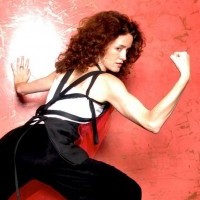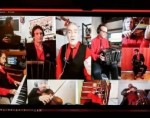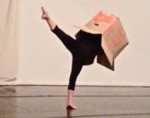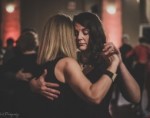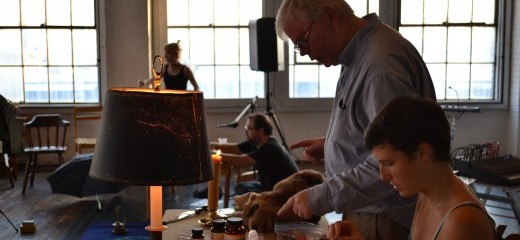
Photo: Joo Won Park
Anarchic Harmony: Cage's Song Books
by Carolyn Merritt
What if the creator’s role was to release into the world a never-ending set of possibilities, whose lives would surely outlive that of their originator?
What if the director/ performer/ audience hierarchy was tossed right side up? The performer became a “thinker,” the audience creative, the director a passive by-stander?
What if a collaborative performance was a meeting of equals? Responsibility was to the self, not the whole? Each individual performer was part of something larger, yet free from judging, worrying, even thinking about others?
What if we allowed ourselves to sit with the silence? Sat long enough through the boredom to recognize its origins within, rather than attributing to forces without?
Enough to notice a skirt’s gentle lift under the exhalation of an air purifier. Watch a kiss between husband and wife, at once themselves at home and performers at play. Contemplate place and space when big wheels and stuffed badgers appear in site specific performance. Distinguish the light of a lone candle, lamp, fluorescent bulb, projector.
Notice time and its dimensions in the steady forward march of a typewriter, the impending end of a running clock, the transcendence of a Buddhist chant, the suspension of flow. Accept a gift freely. Disagree without attachment.
And what if we took these ideas outside the realm of art? Could a world without rulers yield harmony? If we were each obligated to our own tasks. Resisted the compulsion to diversion, constant connection, busywork. And rather, looked, listened, and paid attention. With vigilance and without expectation. One part of a fabric, yet unattached to how the larger weave happens.
These observations while watching and thoughts while listening to the post-show discussion are still kicking around in my mind more than two weeks after Song Books. What is the relationship between art and life?
Art as Life/ Life as Art
2012 marks the centennial of composer John Cage’s birth. In celebration, and as part of their 3rd Annual Fall Experimental Music Festival, thefidgetspace hosted a performance of Cage’s 1970 masterpiece, Song Books, featuring musicians and dancers Mauri Walton, Joo Won Park, Chris Mandra, Rob Haskins, Nicole Bindler, Bhob Rainey, and co-directors Peter Price and Megan Bridge. A two-volume collection of 89 scores that provide instructions for the solo voice, performative happenings, and electronics, Song Books lends itself at once to structure and freedom. As Cage scholar and biographer Rob Haskins explained in his pre-show talk, Song Books, like much of Cage’s work, is “indeterminate.” Each performance is unique. Any number of performers selects the “songs” they will perform, the order in which they will perform them, and the total running time of the event—this one an exact hour, as a projected digital clock ticked off for us to the second. And the scores themselves are open to interpretation. “Seeds” as Haskins called them, they are “productive of something.” For instance, the instruction “prepare something to eat” can yield any number of actions, like eating an apple, as Nicole Bindler did to open her song.
Cage is most celebrated for introducing the idea of indeterminacy to art, and his reliance on the I Ching and the principle of chance in art-making. Over the course of a long and prolific career, he and choreographer Merce Cunningham (his lover and collaborator), institutionalized the role of chance in dance and music composition. After the show, discussants noted that Cage is often claimed by Zen Buddhists as one of their own; less so than by anarchists. But his approach to art was also a philosophy of life and, in his mind, a political stance. As a refrain in one song, Cage quotes Thoreau, “that government is best which governs not at all.”
Cage’s ideas are enticing (individual responsibility), enlightening (embrace boredom), and maddening (continue to embrace boredom). Other artists apparently took Cage to task for “only thinking” about things, and never acting. According to Haskins, Cage wanted people to come up with their own ideas. In art and in life.
What this all means on a friendly night in an experimental art space in East Kensington is up for grabs. Cage was among a cadre of avant-garde pioneers who made this space possible, and we are lucky to have such venues, where artists challenge and provoke with purpose. They engender revelations.
But I am still mulling over the political implications of Cage’s ideas, a focus of our post-show discussion. Even if his vision of anarchy might yield a more equitable world were it achieved, Cage had the freedom to ponder and put these principles into action while so many others do not. They first need significant change in their circumstances. This requires concerted effort, acknowledgment that it is simply not enough to attend to our selves, recognition of our shared humanity and history. Perhaps this is hypocritical; I am not much of an activist myself. Nonetheless, applying Cage’s ideas outside of art raises questions that can’t be answered by thinking alone, and to ignore Cage’s relative privilege (white, male, U.S. citizen, educated, traveled, middle class background) is irresponsible, even if his questions are revelatory.
John Cage: Song Books, fidget’s 3rd Annual Fall Experimental Music Festival, thefidgetspace, October 5-6, 2012.
By Carolyn Merritt
October 26, 2012


